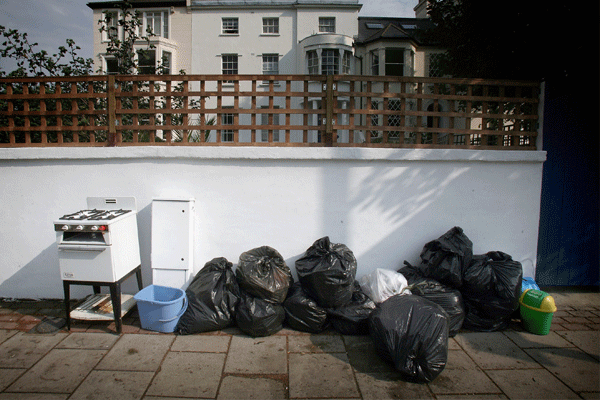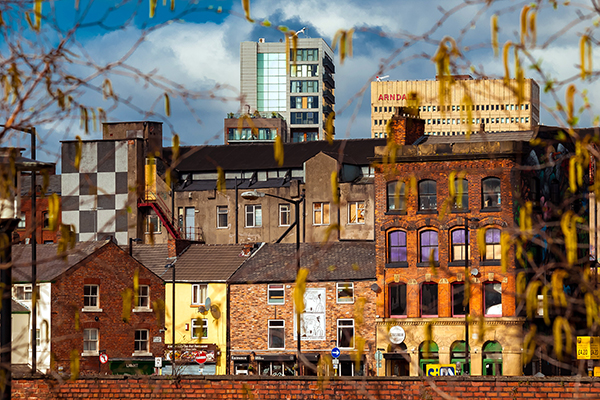This article is the first in a new series by the RSA, exploring the forces that will reshape public services in the decades to come.
Following the referendum, Brexit has predictably become the dominant project of this Government. The impacts of Brexit will reach into all corners of how government operates, and managing the transition will extend well into the 2020s. But the UK’s public sector faces a range of challenges in addressing the changing needs of the society it serves; some are long-standing and others are emergent. It is the responsibility of civil society - including organisations like the RSA - to contribute positively, especially at a time when government’s capacity to think and plan strategically is constrained.

Our starting principle is that public services need more than the public sector to serve the collective public demand for what we want these services to do. By this we mean that as standards, expectations and costs increase faster than our economic growth model can currently sustain through traditional ‘tax and spend’ models, we face a choice of several strategic responses, including:
- Reshaping (turbocharging?) our economic growth model in order to maintain our current model of financing public services. (Arguably, we have a track record of trying and failing to do this; at least within the current economic cycle).
- Becoming more tolerant of a general decline in public service quality: it is likely impacts would be felt disproportionately on those who rely to a greater extent on public services to support quality of life, with the retrenchment of public services so as to prioritise those with the greatest need.
- A drastic reprofiling of how public services operate, accompanied by a shift in public opinion and common perceptions on what public services are for.
This blog series will focus on ‘option 3’, which we have long argued offers the best chance of ensuring people can live the best lives possible.
We predicted in 2014 that by 2020, public services would be more about managing demand for services than managing the services themselves. We have an opportunity to reflect on the challenge we set ourselves four years ago: with the benefit of recent experience in working with councils and public services, we are now able to go beyond a technocratic study of how to reduce and manage demand, and invite a political debate about what public services are there to do, taking a long-term view.
This first blog post simply proposes and invites feedback on a new broad framework for public services. As we develop and share ideas over the coming months, this should help us to consider the breadth and diversity of what we mean when we talk about public services.
Core public services are areas of society in which markets are inappropriate or insufficient, because the logic of universal public protection is strong. Core services tend to ensure people have their fundamental human rights: health, education, safety and justice. These are both the everyday local services like waste management and maintaining roads, and services we all look to in emergencies (although we need them to be available there every day), to reduce and eliminate risks and threats, and to ensure equitable treatment for all in markets.
Auxiliary public services are what we decide, through democracy, tax and expenditure, to organise for citizens that helps support people in their lives when they are in need: a social security safety net. Ideally, we wouldn’t want to ever have to access auxiliary services, but they are best organised as large collectives, which pool risk. Charities also provide many auxiliary services, from advice (e.g. Citizens Advice) to food banks to hospice care.
Regenerative public services are where we look to the public sector to organise activity that improves the fundamental capacity of society (at many scales, including local communities).
From the point of view of strained public services, many regenerative approaches might be considered to be ‘early intervention’ or ‘preventative’ in their approach.
But in using the term ‘regenerative’ we want to think more strategically about the context in which a need for public services arises. People are the ‘renewable energy’ of public services, and efforts of the public sector to boost this potential - including community development, capacity building and economic development - are regenerative in that they seek to catalyse stronger self-organisation among a range of different communities.
The productive potential of people to create products and services of value is also, in the main, self-organised but relies on governments to govern, to regulate and to coordinate basic infrastructure, upon which a market economy can thrive. And, of course, when it comes to the ultimate goal of good health and wellbeing, most care and support for this is provided without state involvement: as self-care, care from friends and family and neighbours and mutual care within communities. Some describe this as the ‘core economy’ to recognise the value and status of this work.
Here is why we think this framework is useful: the more you think about a public service, the more you realise that in reality, to be successful a public service actually needs to have mini-services across all three elements of the framework. And when we realise that, our natural human instinct to problem solve, to avoid waste, to find communal solutions and socially regulated behaviours kicks into gear.
We start thinking of a service as a series of mini-services. Each helps us to achieve better lives, within the complex and messy systems of everyday life. Each one does different things. And public services inevitably struggle when the mini-services don’t work well together. It is for this reason service design is an increasingly popular methodology across public services.
And it is why our Inclusive Growth Commission concluded that to underpin an inclusive economy, good social policy and investment in social infrastructure can’t be ‘preoccupied and paralysed by existing systems’.

Waste in the system
Think about bin collection. Everyone creates rubbish. For most of us, we put stuff in a rubbish bin and a recycling bin, and then barely think about it again. Indeed, usually we only engage our brains when something has gone wrong in the bin collection system. Everyone uses this public service - organised by local councils - and it perhaps dominates our basic understanding of what our local council does. Bin collection is a core public service, and even during the grips of an austerity drive, central government created a £250m fund in 2011 to support local councils to maintain weekly bin collections.
But look at the big picture: collecting bins is just one part of a system of waste management. Waste management isn’t really a service, it is a series of mini-services. At the core are the visible elements: people employed to pick litter, collect bins, and drive waste to landfill and recycling centres. But there is an auxiliary element, which introduces special service and charges to manage waste at scale - beyond the everyday flows through the household.
This includes the collection of bulky or specialist items which need special handling. Waste from businesses - whether manufacturers, building sites or high street shops and restaurants - operates under separate commercial contracts. But where is the biggest potential to address the 556,000 tons of waste produced every day? It is in regenerative approaches.
Recycling is not regenerative - it is the recovery of waste material. The ultimate system lever is encouraging people up the familiar reduce>reuse>recycle hierarchy. Sending less stuff to landfill lowers the material and environmental footprint of the things we decide to consume in order to lead good lives.
In short, the route to managing waste as a system, rather than waste management as a service, is harnessing our collective energy across society to reduce waste - which tracking back to initiatives which regenerate our ability to live better while consuming less.
We need to consider the anti-consumerist movement Buy Nothing Day through to the the conscious consumer models of Carrotmob, to the mending and reuse of stuff, to the collaborative consumption of Streetbank, Freecycle and Library of Things.
This is before we even get to ‘nudging’ campaigns like Keep Britain Tidy, or the efforts of the waste management authority (the local council) itself to educate the public about the financial cost of waste generated (reinforced through the Landfill Tax); for example through issuing warning notices to households who aren’t separating landfill rubbish from recyclables.
A healthy system of services
The most famous public service we have is the National Health Service. But really, it quite obviously isn’t a single service. For example, vaccinations at birth against common diseases are a core (mini) public service delivered by GPs, at the prompt of health visiting services, and under the supervision of Public Health England (and equivalent bodies).
Through history, this system has evolved, and, basically, worked: vaccination take-up is almost universal, many diseases have been marginalised, and some completely eradicated. This is perhaps the biggest achievement in the history of public health. But each of those service bodies operate in a diversity of ways, too.
GPs are largely an auxiliary service - we seek treatment when we are sick. Health visitors largely have a regenerative role: they would see their principle objective as ensuring babies are healthy by building the capacity of parents.

Using England as an example, PHE do a bit of everything: they are an auxiliary response to emergencies such as the Ebola epidemic, they are also regenerative in that they seek to encourage healthy behaviours in diet and exercise.
And with that difference comes a different relationship to the wider systems that keep the public healthy - beyond public services. On Ebola, PHE was at the forefront of coordination, providing professional advice to local health services, relevant organisations such as airlines, and the general public.
In seeking to reduce obesity, PHE works on many fronts: Change4Life is a public education campaign, the sugar reduction programme includes work with food and drink manufacturers and retailers, as well as schools. Obesity is a classic example of where positive change seems just as likely to come from a social movement as much as a silver bullet ‘policy presumption’ mentality; obesity reduction is simply too systemic, as a challenge, to be reduced to a public service.
Locking up, reaching out
Now let’s look at what happens when a system is oriented toward a narrow set of definitions about what mini-services can and should be…
In the criminal justice setting, there is far too great a focus on the “core” and the “auxiliary”. Popular calls for more and more police patrolling the streets (the core), and a reactive approach to crime resulting in ever growing prison numbers (the auxiliary) have been able to prioritise public debate.
In this setting they are the politically easy solution to difficult problems. It feels like a good idea to focus on the punitive, for example campaigns to lengthen minimum prison sentences for animal cruelty offences have often ignored the evidence on the effectiveness of prison in reducing future crime. Making sentences longer and tougher instead of looking at how we might prevent these crimes in the first place (including supporting rehabilitation) has created a system in crisis.
Our current prison system cannot safely accommodate 86,000 people at any one time but, for political and sometimes ideological reasons, no recent government has been willing to make the case for locking up fewer people. The regenerative work of crime prevention that would mean fewer victims and fewer people committing crimes has not been a priority for our political leaders and, as it stands, the balance of core, auxiliary and regenerative is out of kilter.
Protecting the regenerative
In 10 years since the financial crash, through subsequent recession, changes in public service provision have been most obvious in services which are primarily considered ‘regenerative’, using our framework. Although the economy has grown and employment has risen, with rising in-work poverty and larger numbers of people in poor health (especially in old age), spending on welfare benefits - ‘social protection’ - has risen, overall, too - even as specific rates for individuals have been frozen.
With successive central government policies of overall spending restraint and austerity, spending cuts have fallen on services which aren’t legally mandated or related to more critical or urgent care and support. A lot of such non-statutory services are typically provided by local councils, but there is no legal obligation to do so.
Things have varied between localities, but services typically facing the most significant cuts have included public transport, libraries, arts and cultural provision, parks, youth work and youth clubs, careers advice, libraries and multi-purpose community centres, as well as administrative functions planning departments and enforcement of regulation.
The value of these services is particularly hard to evaluate, as often regenerative services are about building people’s capabilities for the long-term, in the hope that they lead to more productive, rewarding, healthier and happier lives than they would have likely done otherwise. When faced with shrinking budgets and difficult choices, cutting public spending on community festivals and fireworks displays might be the least unpopular option. Frontline services are the most visible, and there is public support to protect them.
The challenge is that negative impacts - in communities where play spaces and activities for young people are insufficient, where literacy support and English language courses can’t reach marginalised adults, or where planning teams that can no longer afford to make plans for how development can best benefit town centres and neighbourhoods - are hard to understand, let alone measure; the impacts are often felt only by a small number of less powerful residents, and it can be hard to differentiate in a complex and changing world where lots of stuff is changing all the time. But clearly, in the long-term, achieving inclusive growth depends on investing in social infrastructure and social outcomes.
What is key is to get the right balance between the core, auxiliary and regenerative when designing public sector interventions. Most of society’s problems - crime, poverty, mental health problems, homelessness etc - need a combination of approaches, but the mix is often not ideal for the contemporary challenge.
The mix will be influenced by history, and deeply held views and values. The mix is political, but it is our contention that public engagement and involvement in the complex decisions between central and local government, between dozens of departments, is insufficient to get the best outcomes.
We need to be much more pro-active to better involve citizens in shaping inclusive strategies for their place. Public services are at the heart of this. That is why the RSA has examined how local service redesign can be best shaped with the involvement of local people, and why we are piloting deliberative approaches to policy-making. Interestingly, some councils have empowered a network of community organisations as strategic partners, devolving decisions about what neighbourhood services should look like closer to the neighbourhood level. What all these initiatives have in common is that they are experiments in whether giving citizens more say leads citizens to prioritise regenerative approaches.

(Conclusion) The future of public services: an emerging picture
When you think regeneratively, you start to think: why do we have public services in the first place? Can’t we all just take care of ourselves and each other? Is that what we should be working towards? It is a cliche of those working in regeneration that they are working to put themselves out of a job.
There are many parts of the world - and many pockets of the UK - where community, household and individual self-reliance is much more prominent than the role of government and public services. But, for the most part, the history of civilisation and government is intimately linked. The earliest civilisations saw farmers build shared irrigation systems.
The first public services, over 4000 years ago, were basically government projects to build regional scale canal infrastructure, supplying water to farms and growing cities. Organising improvements to the built environment, with wide public benefit but beyond the capabilities of households, businesses and local communities, led to the municipal projects of street lighting, sewer systems and public transport services which shaped Victorian British cities. Core public services of police and fire were created first in London and Edinburgh, respectively, in the 1820s.
As people came to live in larger communities, connected to each other in increasingly fast and dense networks, the potential for anonymity grew, with people feeling distant and alienated from the complex systems of services on which they came to rely. For example, it is no longer necessary to know how to grow food or cook food in order to eat well: all you need, essentially, is money.
Part of the neoliberal ideology is a critique of the role of government in fostering such sentiment: best expressed in the phrase ‘nanny state’, in which the government’s complex array of services is framed as interfering and inhibiting the development of autonomy and self-reliance which are seen as desirable character traits in individuals.
The principle of services funded publicly through government taxation remains contentious for neoliberal politicians. The contracting and commissioning of public services, and the appropriate role of the private sector, is a live political debate across the world’s countries. We hope that our framework can help people consider their views on these contemporary challenges.
When we succeed, we succeed because of our individual initiative, but also because we do things together. There are some things, just like fighting fires, we don't do on our own. I mean, imagine if everybody had their own fire service. That would be a hard way to organize fighting fires. - President Barack Obama, 2012
So, how do we ensure the right mix between core, auxiliary and regenerative? And how can public services of the future use this framework, and the RSA’s wider experience, as their challenges and priorities change?
That will be the subject of blogs from different members of our Public Services and Communities team. Next up, we will highlight 10 examples of new public services, which demonstrate how our expectations of what public services are there to do are rapidly shifting.


Be the first to write a comment
Comments
Please login to post a comment or reply
Don't have an account? Click here to register.